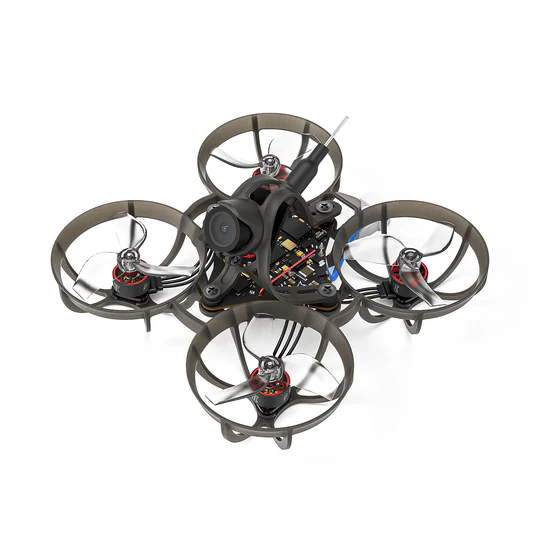2
The Radiomaster GX12 is packed with features and offers a high level of customization for just $169. Designed for pilots who desire versatility and performance in a compact, travel-friendly format, the GX12 includes features typically found in more expensive models, making it an appealing choice for a diverse set of users. This review explores the GX12’s features, design, and performance, providing insights to help you decide if it suits your needs.
What’s in the Box
- A durable carry case
- Screen protector
- USB-C cable
- Stickers
- Manual
Note: Batteries are not included. You can purchase compatible batteries separately.
Specifications
- Internal RF Module: ExpressLRS 2.4GHz / 900MHz Dual Band XROSSBAND
- Protocol: ExpressLRS 2.4GHz / 868MHz / 915MHz Gemini-X
- Internal RF Output Power: Up to 1W
- Cooling Fan: Yes
- Antenna: Two 2.4GHz / 900MHz omnidirectional folding antennas
- Current Consumption: 390mA – 1000mA (varies with RF output)
- Radio Firmware: EdgeTX
- Channels: Supports up to 16 channels (receiver dependent)
- Input Voltage: 6.6 – 8.4V DC
- Battery Options: 2S LiPo or two 18650 Li-ion cells or 21700 (batteries not included)
- Charging: USB-C
- Display: 128×64 monochrome OLED display
- Gimbal: GX01 1000Hz, 3D digital CNC hall-effect gimbals with folding sticks
- Gimbal Sticks: 3mm thread
- External RF Module Support: Lite module bay (Crossfire compatible)
- Firmware Updates: EdgeTX and ELRS via USB-C
- Memory: 512MB internal flash memory for EdgeTX system
- Dimensions: 183x148x78mm
- Weight: 670g (including two 18650 batteries)
Compact Design
The Radiomaster GX12 is similar in size and layout to the Jumper T20S, a favorite daily driver among many pilots. It’s exciting to see how the GX12 positions itself as an alternative.
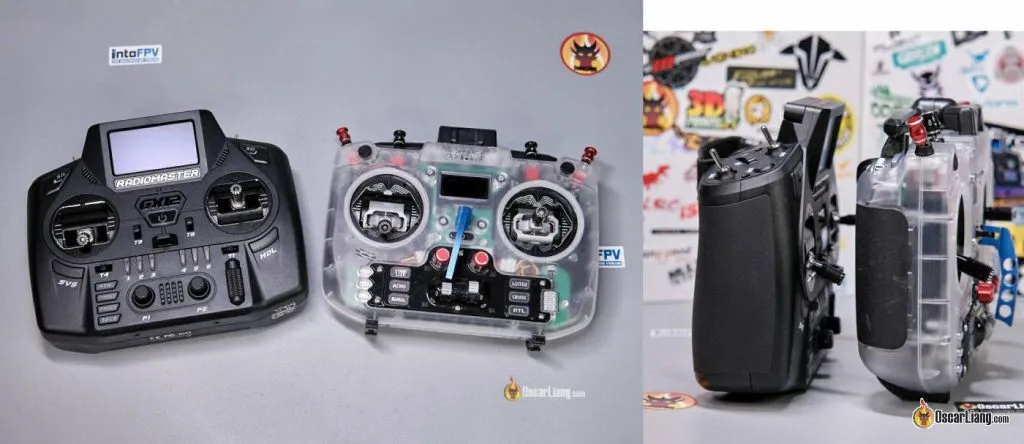
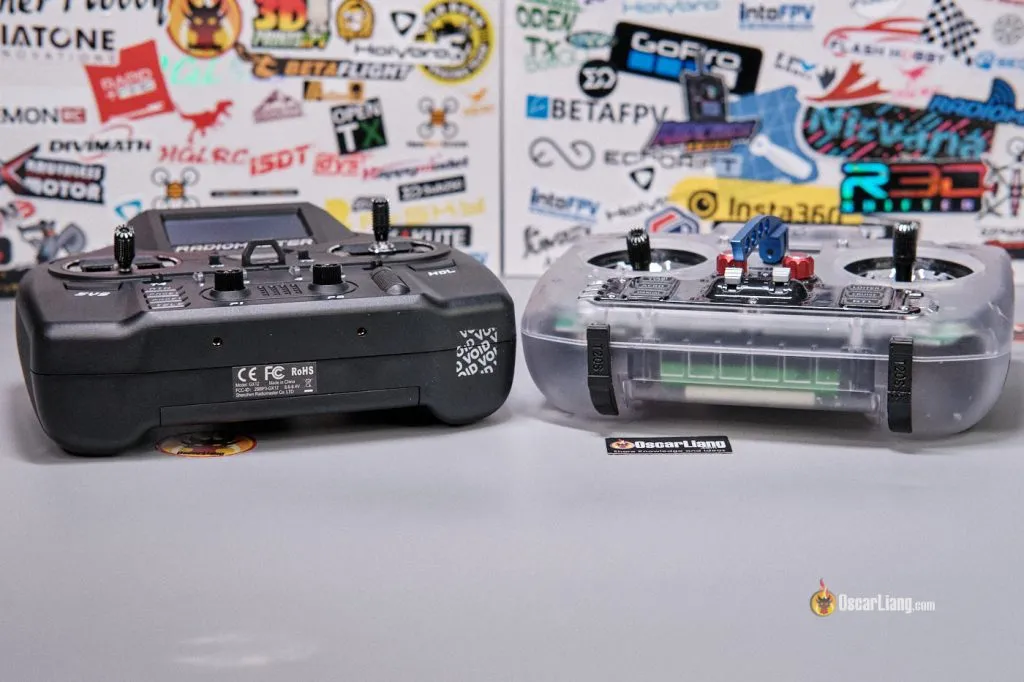
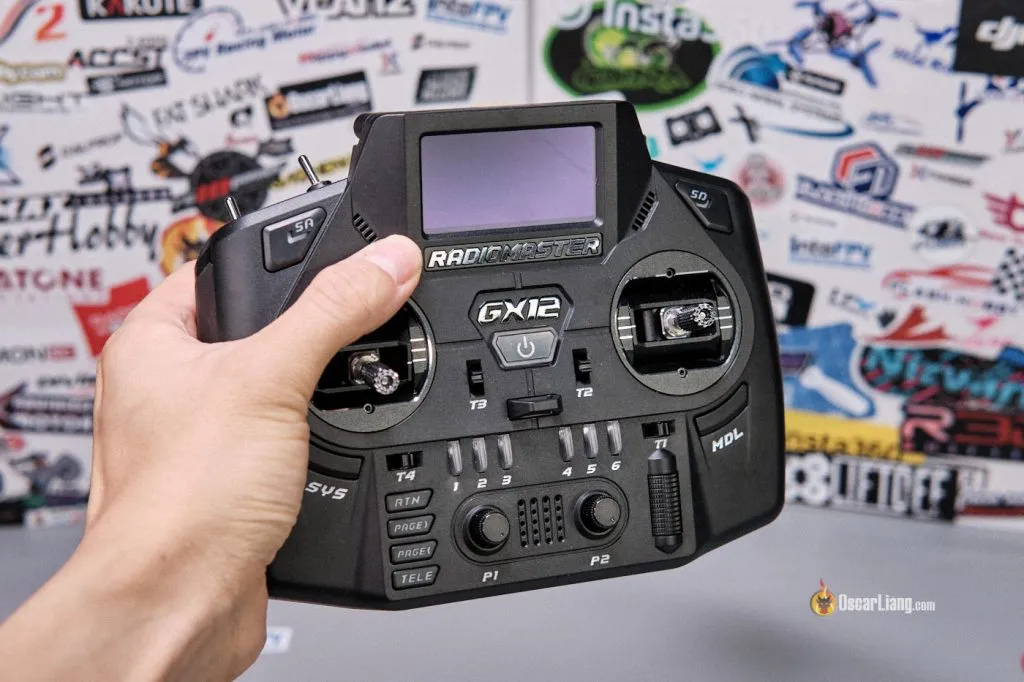
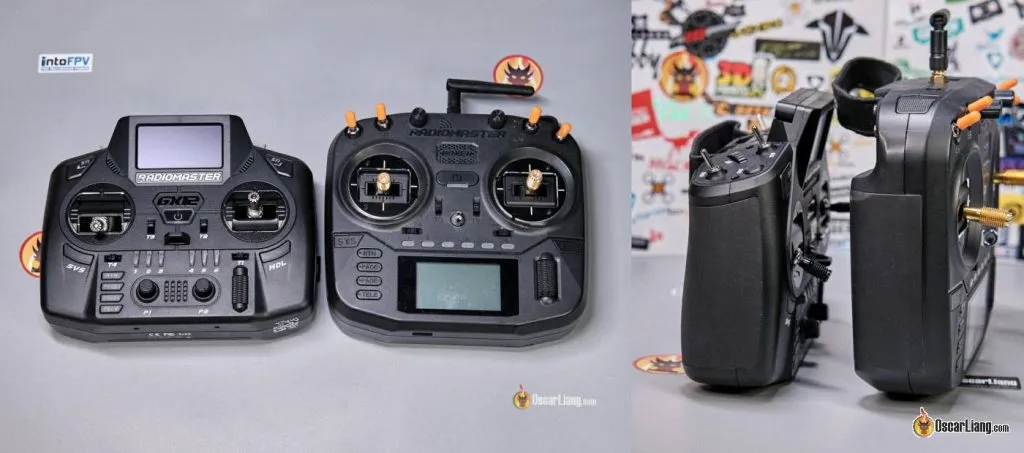
For ultimate portability, Radiomaster’s Pocket remains the brand’s smallest and lightest transmitter, significantly more compact than the GX12.
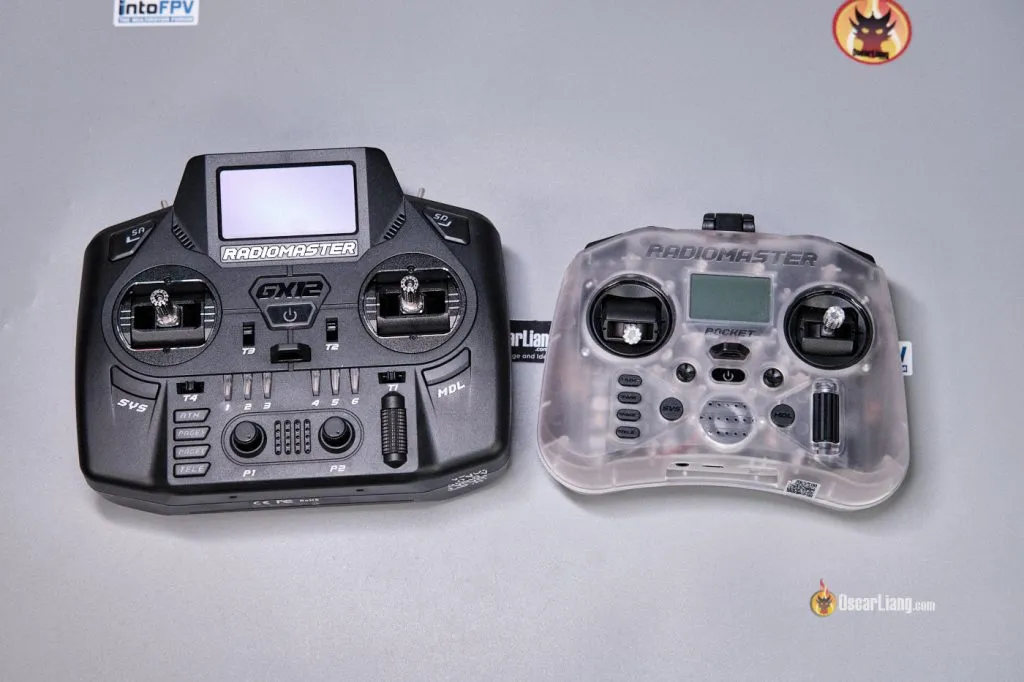
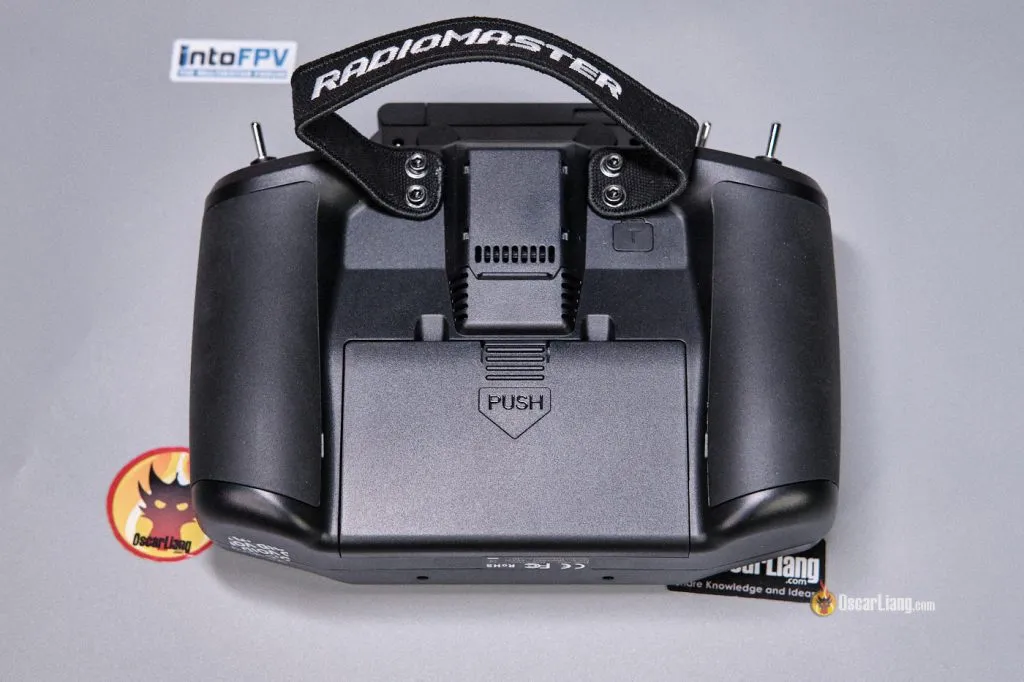
Build Quality
The build quality of the GX12 matches other Radiomaster models like the Boxer and Zorro. While its plastic housing doesn’t convey a premium feel, its $170 price point delivers solid and confident construction. The plastic is durable, without creaking or rattling under pressure.
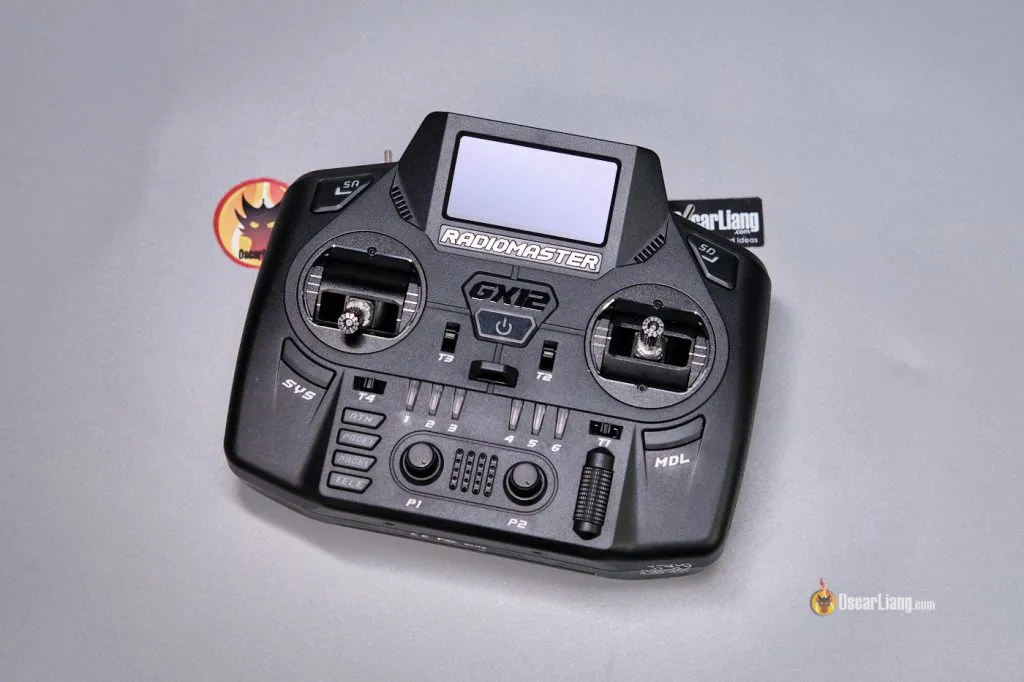
Switches And Controls
Although the Radiomaster GX12 primarily targets FPV drones, its range of features like trims, sliders, and customizable switches make it versatile enough for fixed-wing pilots using systems like iNav or Ardupilot.
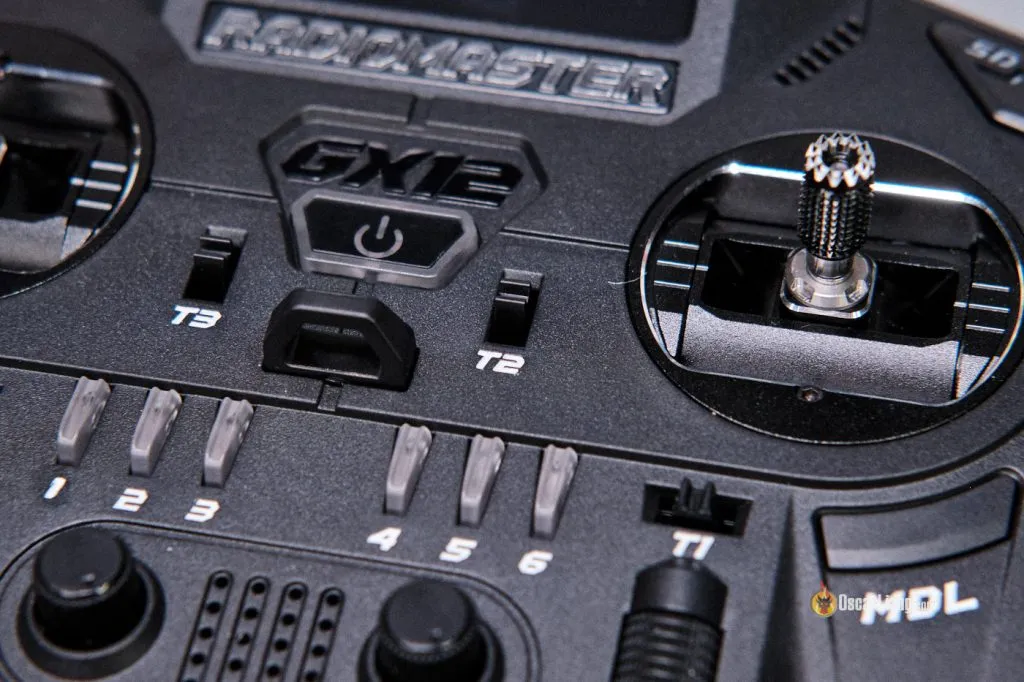
Plenty of Switches for All Needs
The GX12 includes numerous switches, featuring four switches and a slider at each corner. For quad pilots, this might be excessive, but for fixed-wing pilots needing control for features like flaps and landing gear, the GX12 is well-equipped for complex setups.
Interesting Switch/Button Choices
Each GX12 corner includes:
- Two 3-position traditional stick-style switches
- Two single-press momentary buttons
This design might feel too focused on momentary buttons; replacing some with latching switches could enhance versatility.
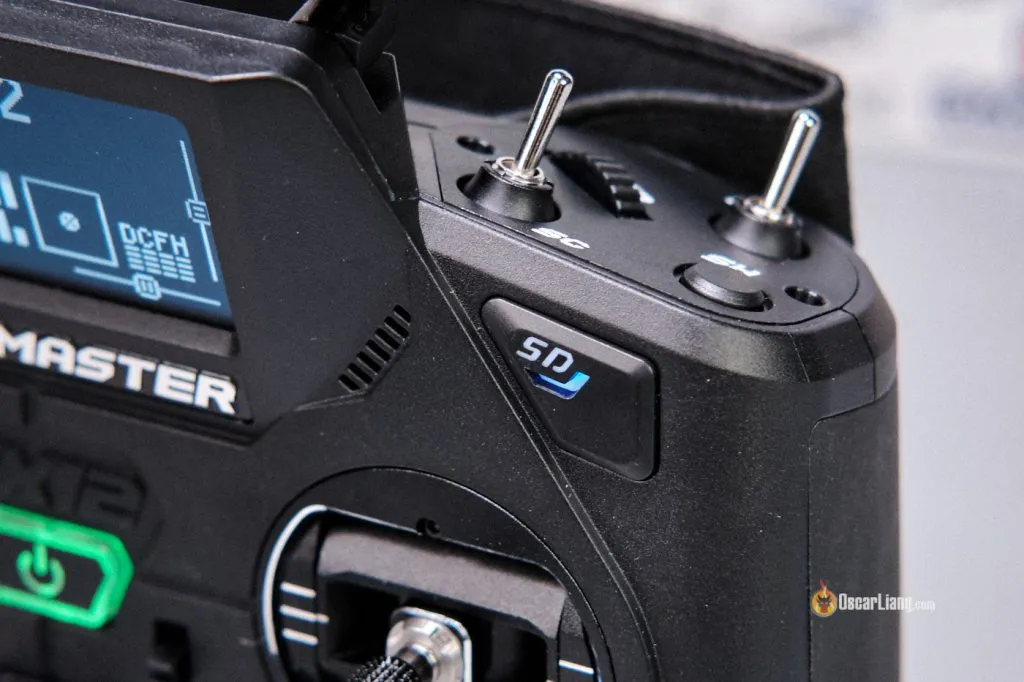
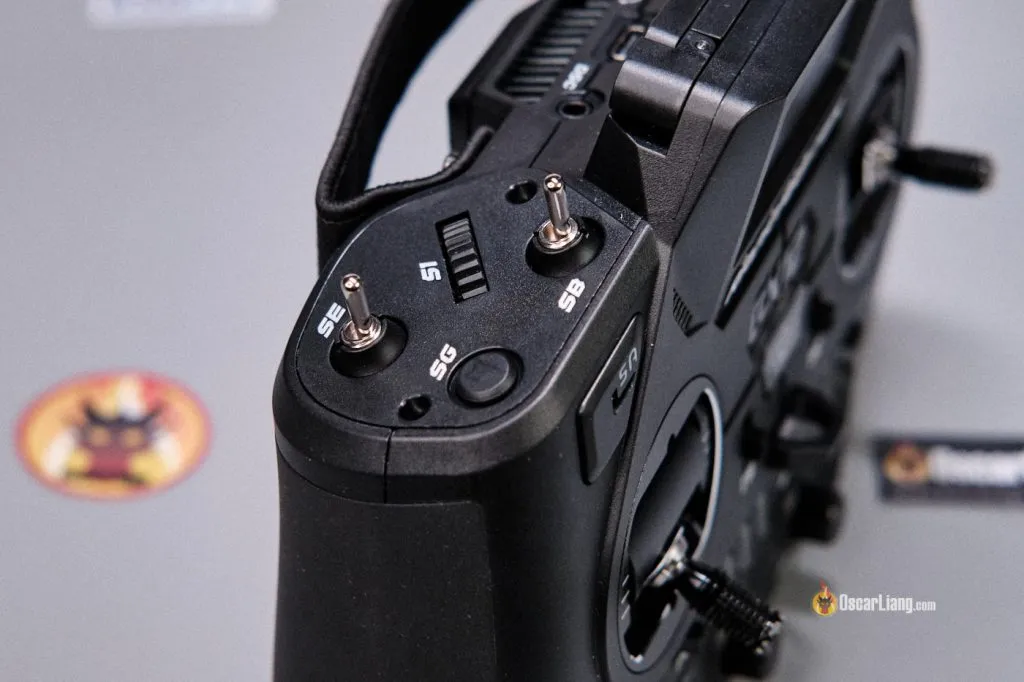
Swappable Corner Panels
The GX12’s standout feature: swappable corner switch panels. They let you remove the slider for a simpler configuration.
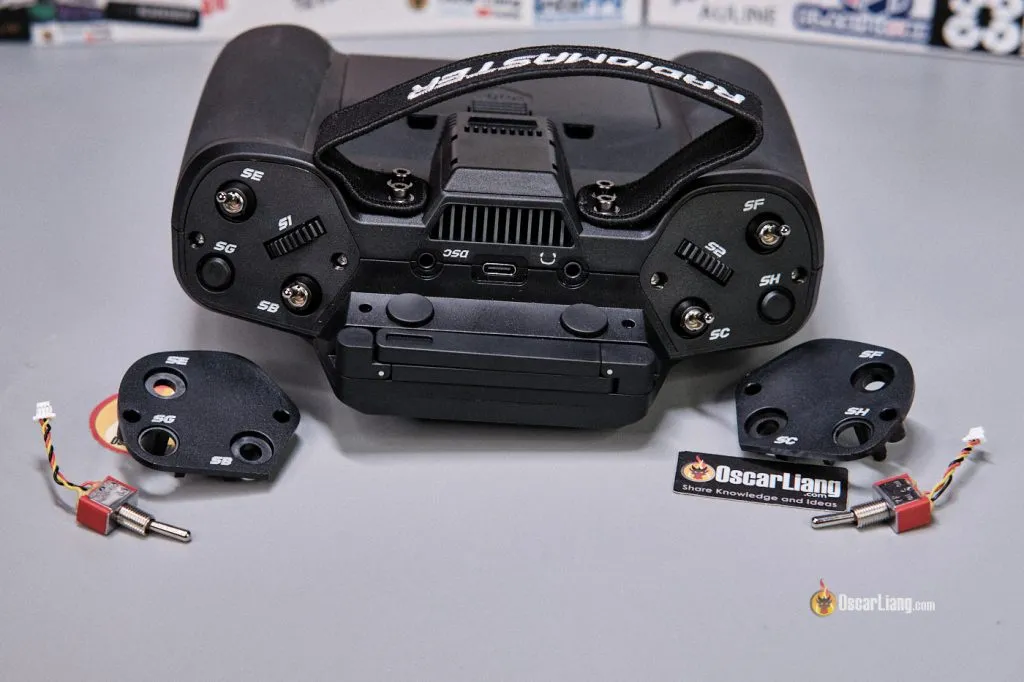
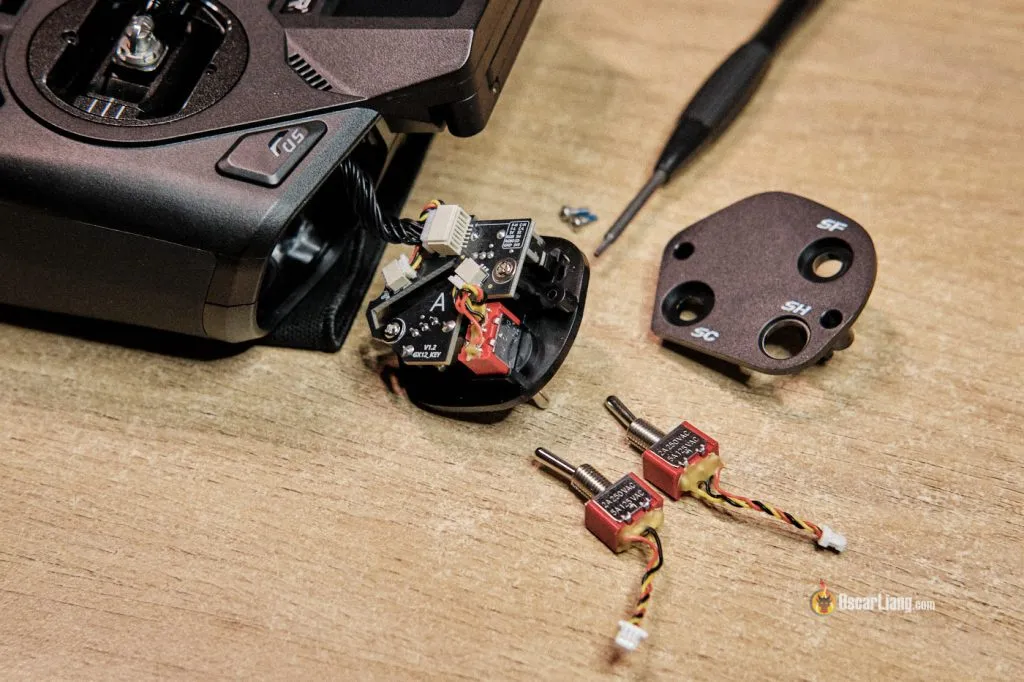
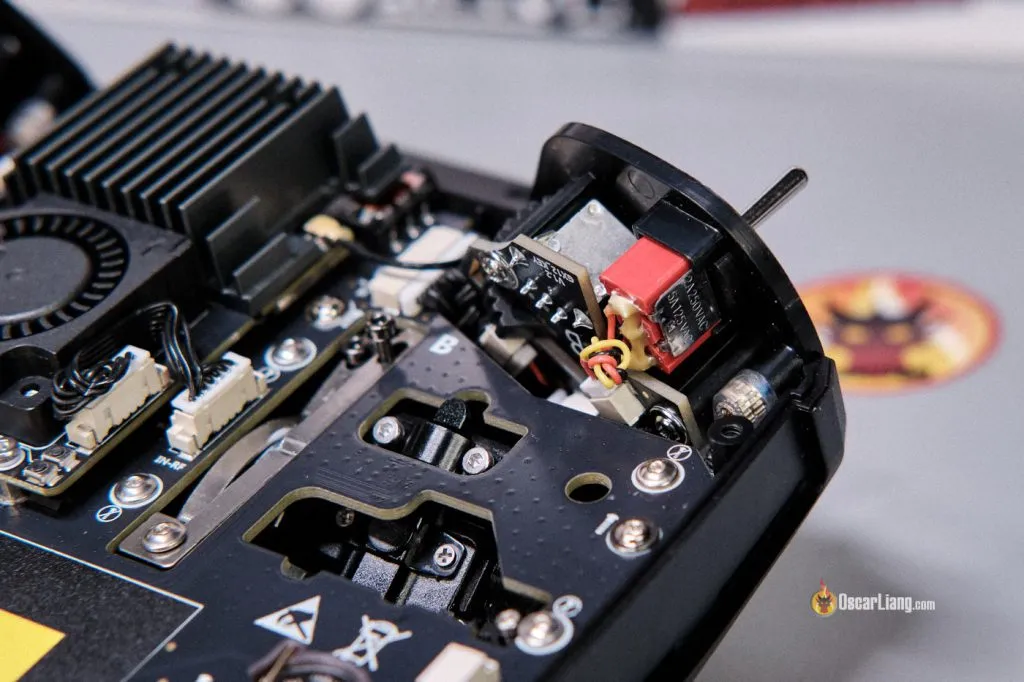
6-Position Flight Mode Buttons
The GX12 includes 6-position flight mode buttons seen on other Radiomaster radios, now with RGB LED backlighting for low-light visibility and mode identification. These buttons preserve their state between uses.
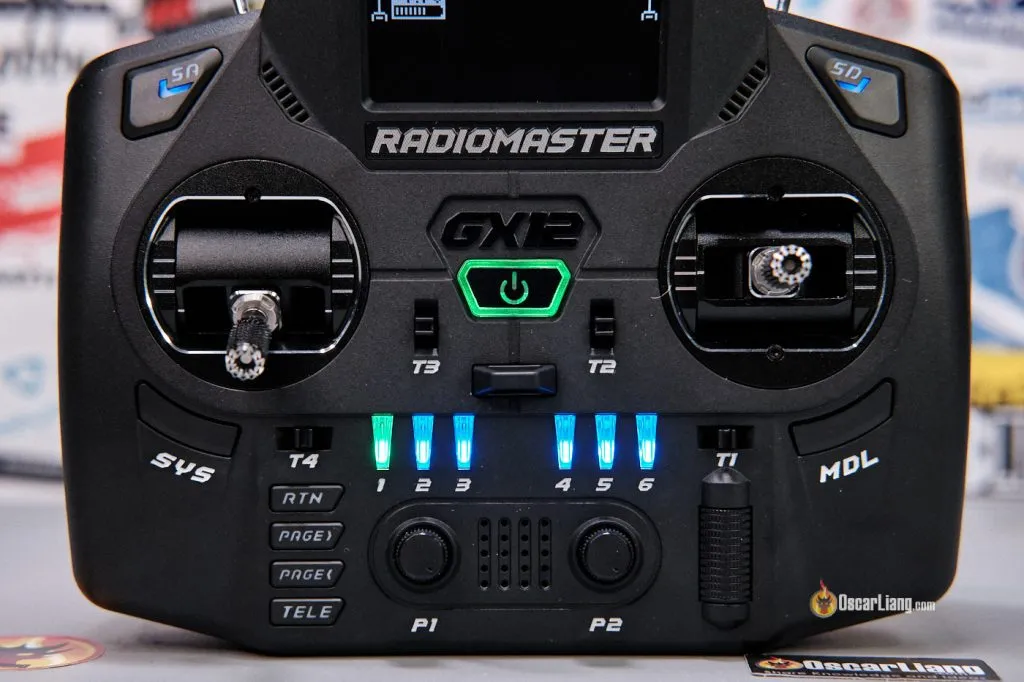
Gimbals
The GX12 debuts Radiomaster’s GX01 gimbals, which are CNC aluminum hall effect gimbals with foldable sticks—offering a unique portability advantage.
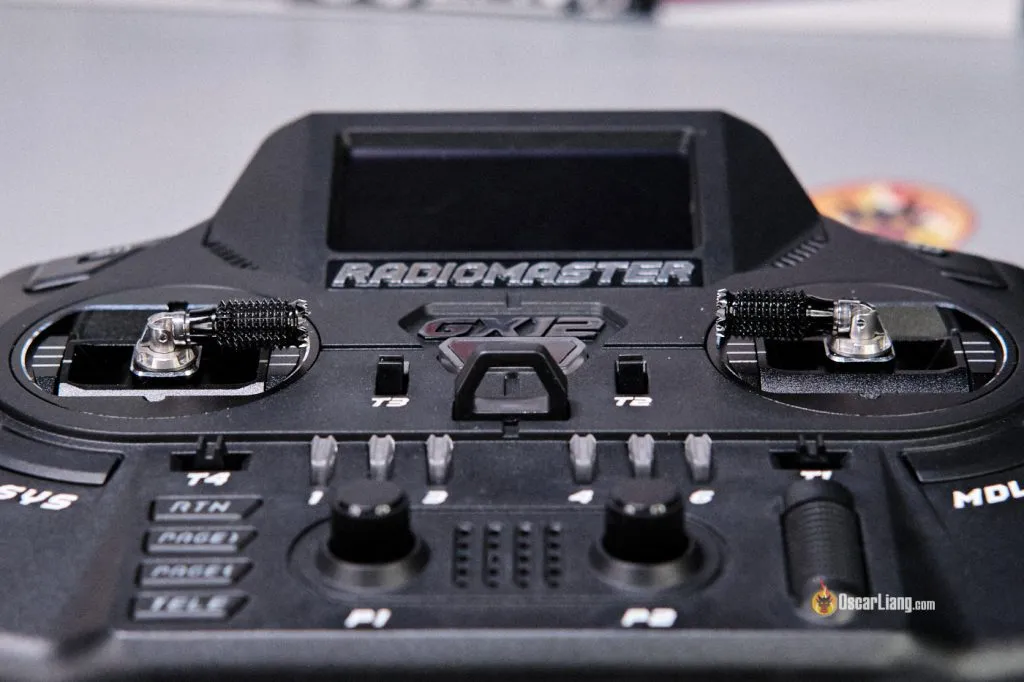
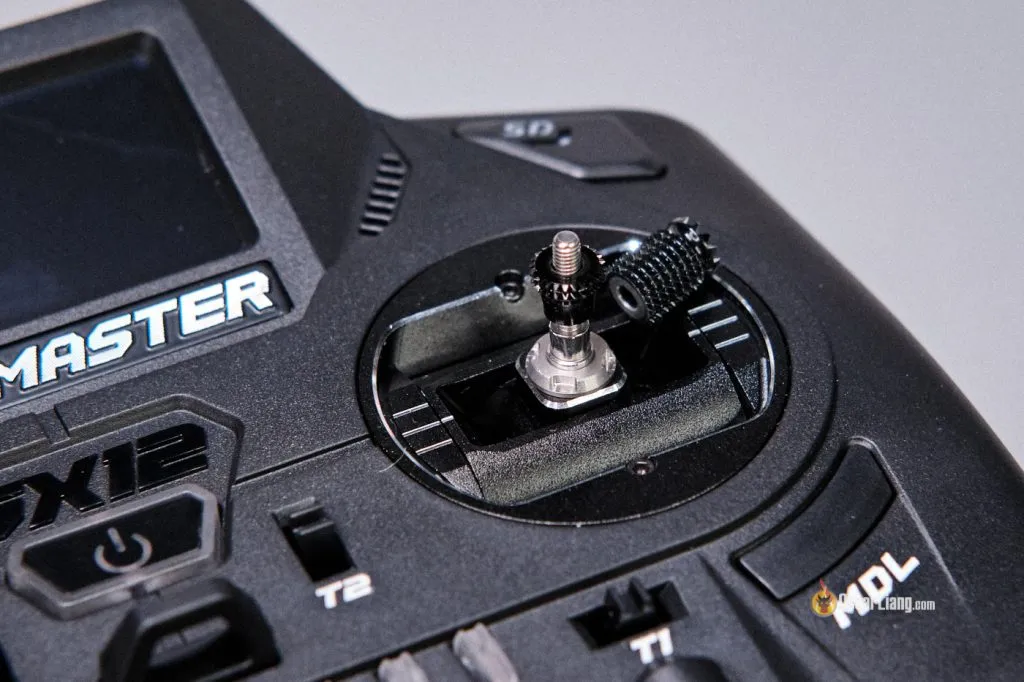
Compact Size with Trade-offs
The GX01’s smaller size than full-sized gimbals in other models results in reduced throw and precision. Despite being suitable for sceneries, full-sized gimbals offer finer control that’s especially noticeable in precise maneuvers.
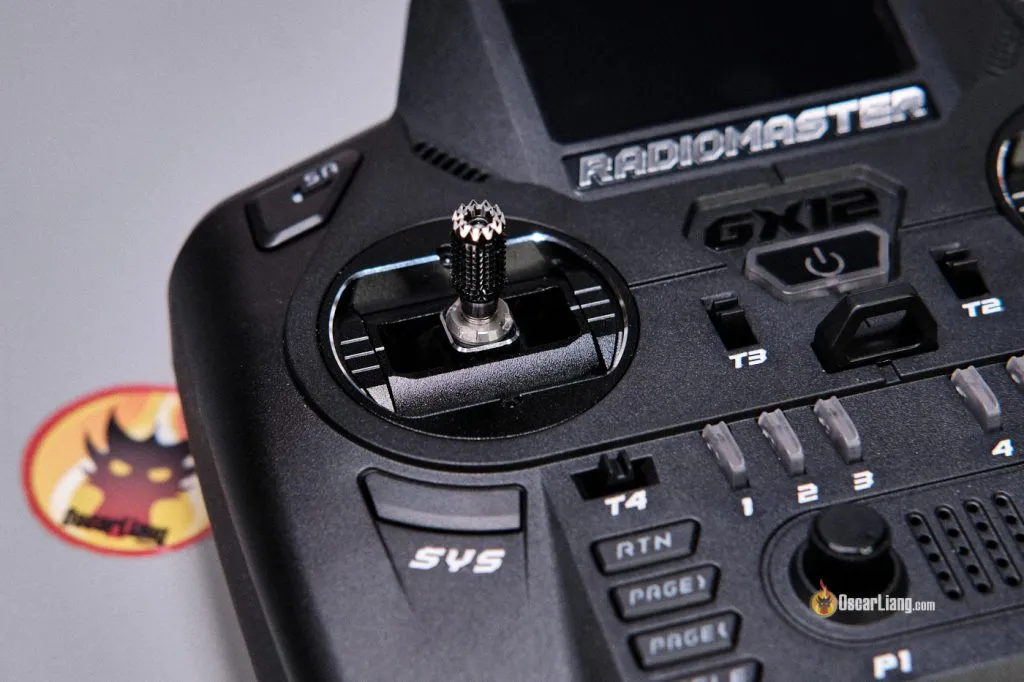
Compatibility and Limitations
Unfortunately, the GX12 only supports GX01 gimbals, excluding premium upgrades like the AG01. While the GX01 offers portability, some users prioritize the refined feel of premium gimbals.
Gimbal Tension Adjustability
The default tension was slightly tight for my preference, but adjustments can be made easily via the rear access holes.
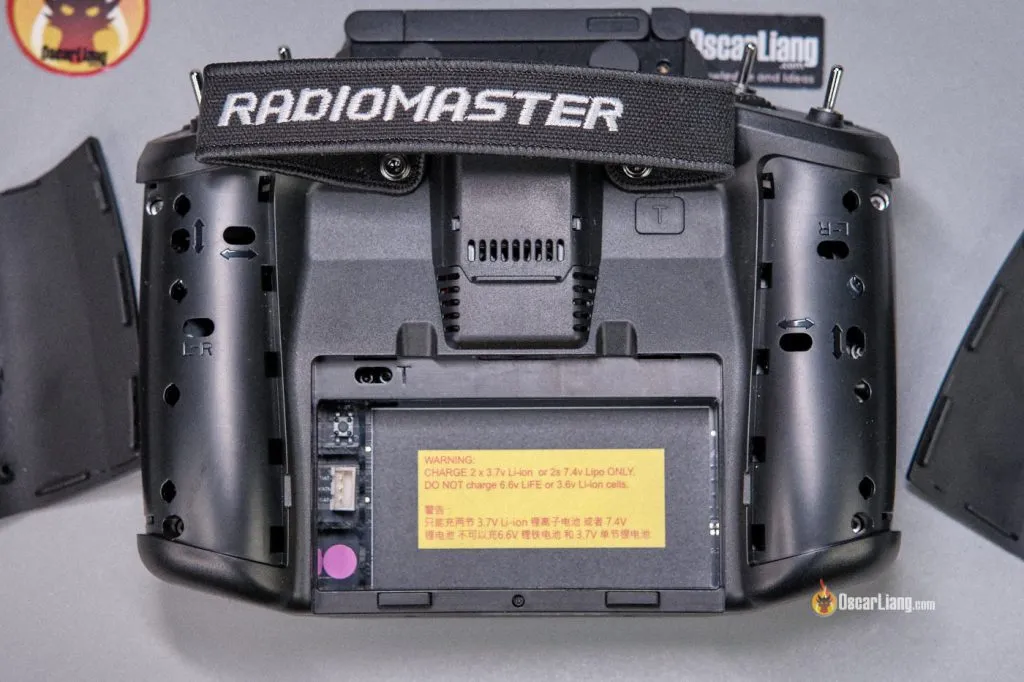
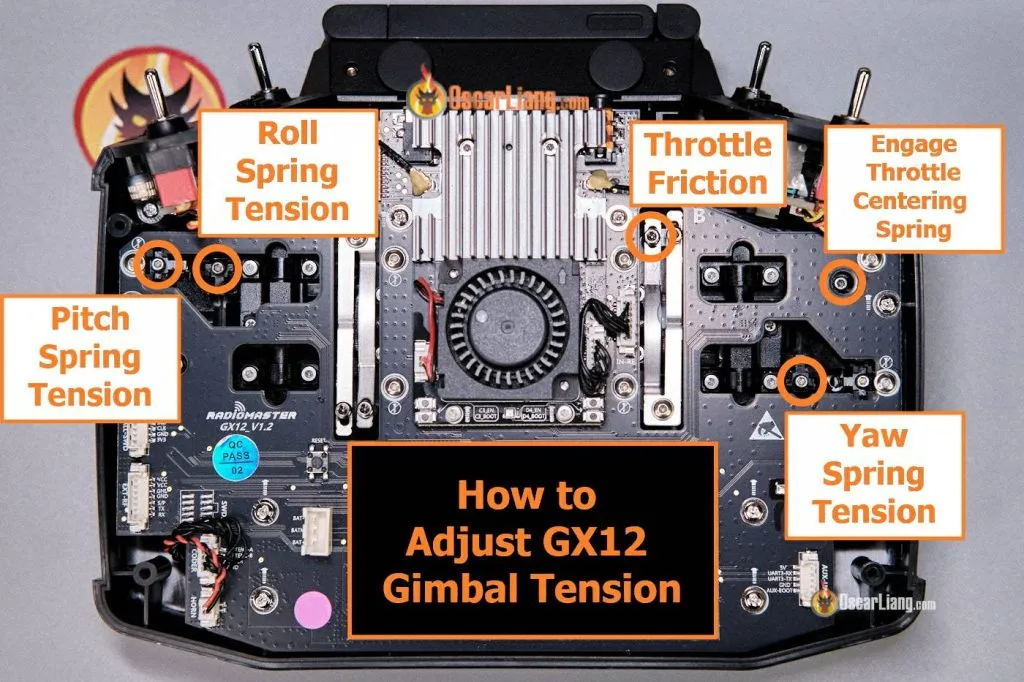
Stick Travel Adjustment
The vertical throw can be adjusted using front hex screws of the gimbal.
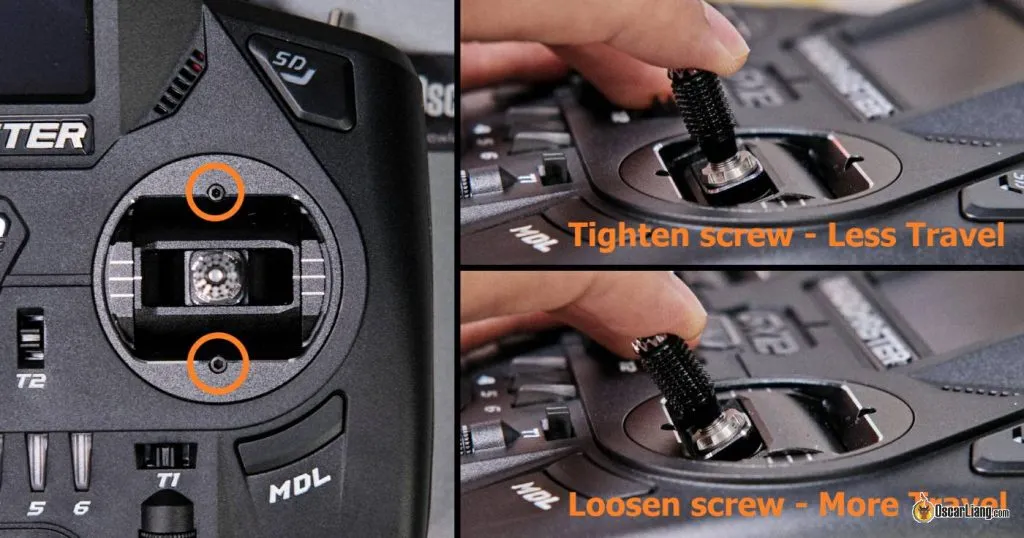
Display and Menu Buttons
The GX12’s 128×64 monochrome OLED screen improves upon other models, providing high clarity even in sunlight. While it’s not a color touchscreen, this choice aids battery life and simplicity—ideal for FPV setups.
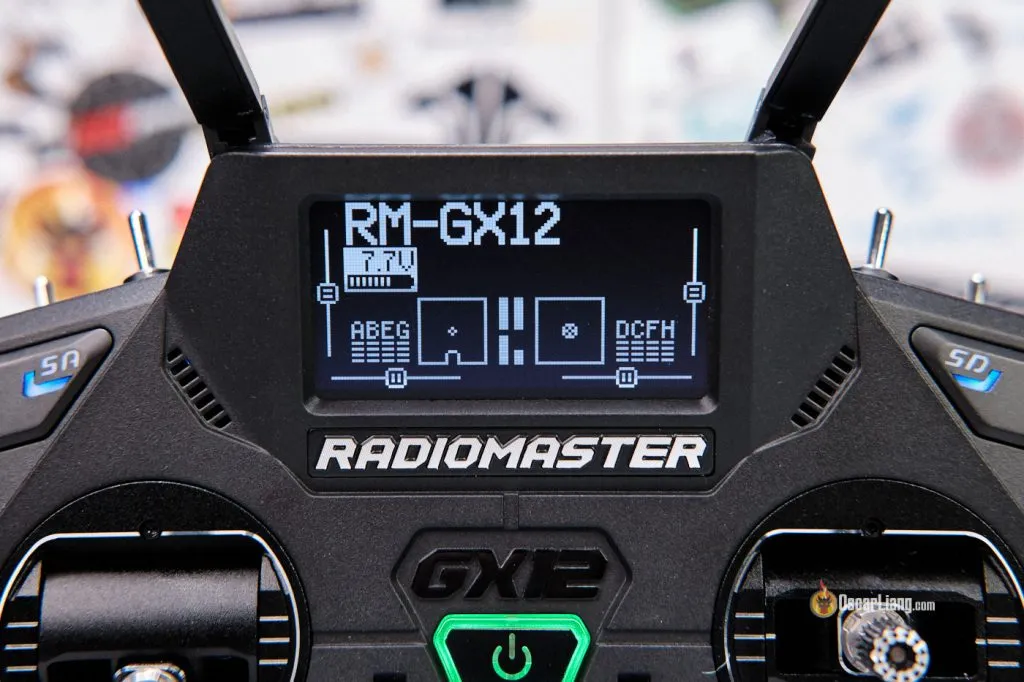
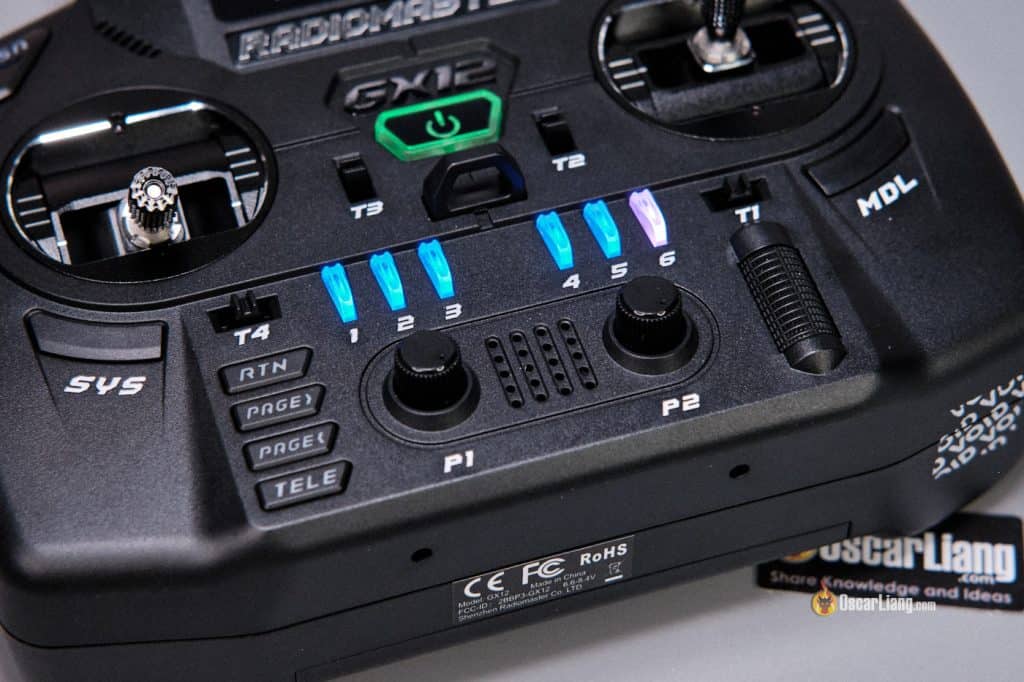
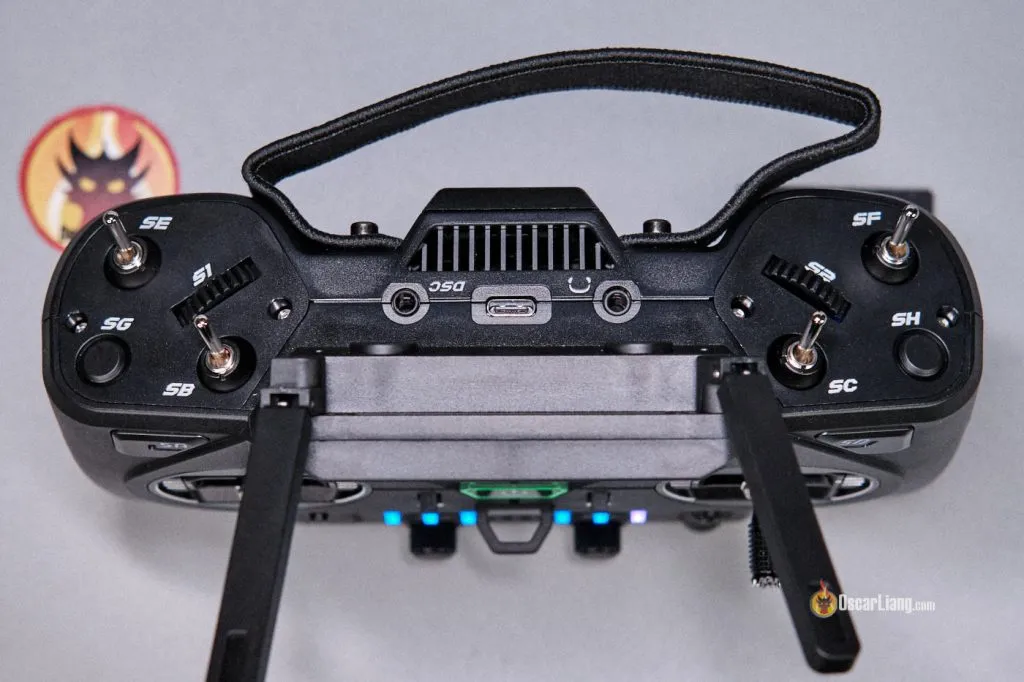
Ergonomics
The GX12 has a thick, ergonomic housing perfect for solid grip, suitable for both thumbing and pinching styles.
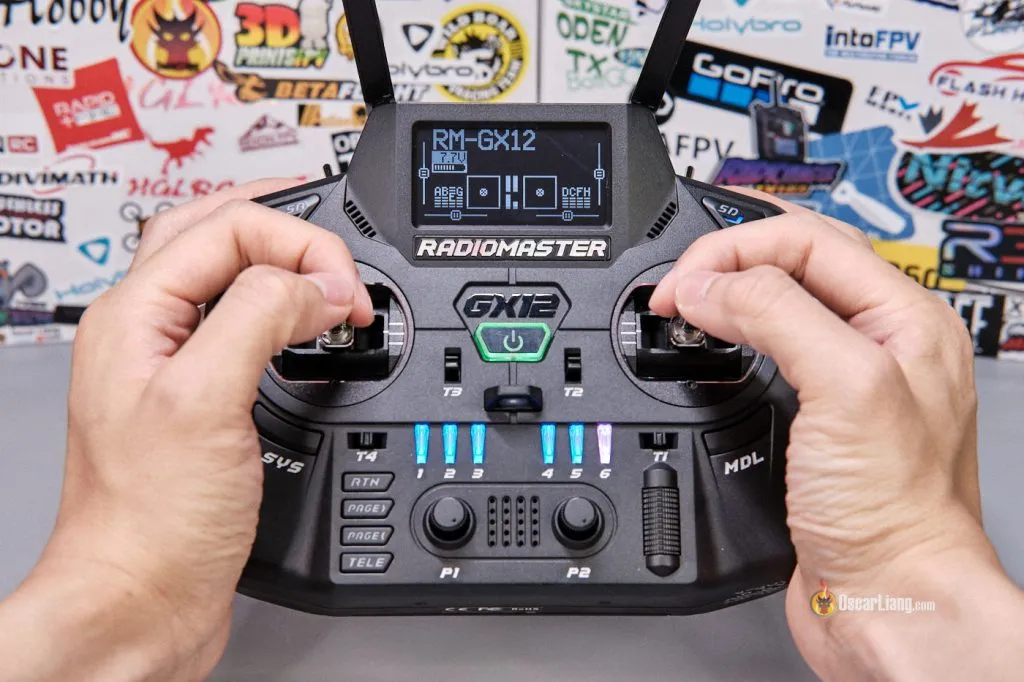
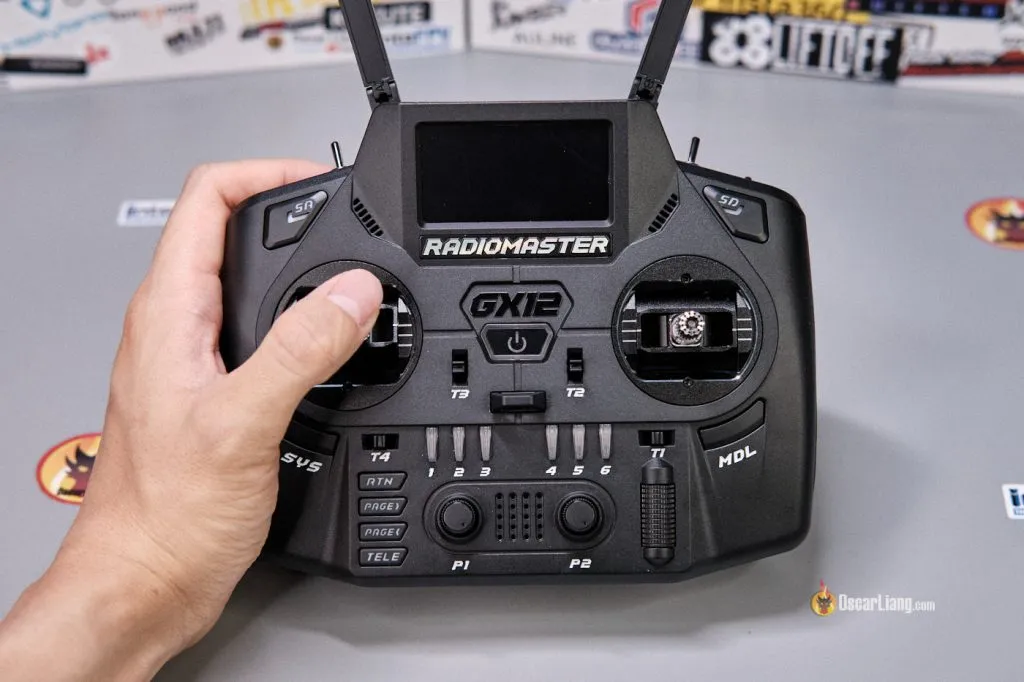
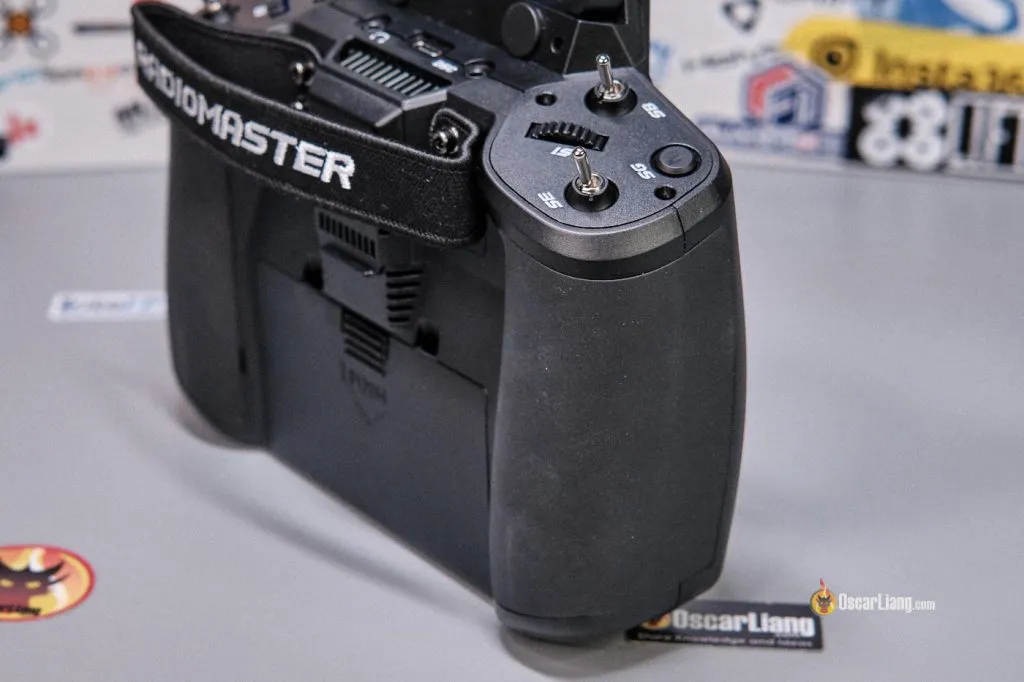
The switch placement isn’t ideal. Short, stiff switches are far from the fingers, requiring finger removal from sticks for operation. Considering using button-style switches as seen on other models might have been a better choice.
EdgeTX
The Radiomaster GX12 runs on EdgeTX firmware, offering vast flexibility and control but a learning curve for beginners. Onboard flash memory replaces the micro SD card to store system files, increasing file transfer and update speeds—an approach I find particularly appealing.
ExpressLRS Dual-Band Technology
The GX12 features a 1W dual-band ExpressLRS module that transmits on both 2.4GHz and 868/915MHz simultaneously, ensuring robust radio links with Gemini-X technology. The Nomad module integration enhances dual-band capabilities compactly and affordably.
The internal RF module runs on ExpressLRS firmware, while the onboard lite module bay allows use of other protocols like TBS Crossfire.
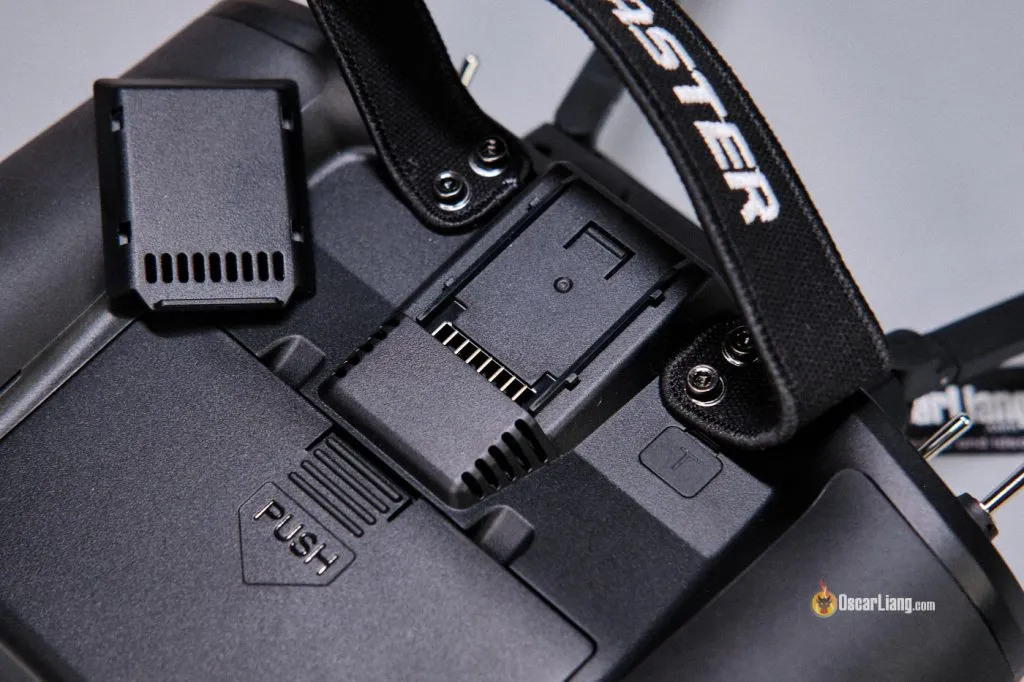
Is Dual-Band Necessary?
Most pilots might find the Gemini-X dual-band unnecessary, as the 2.4GHz module already supports long ranges. However, pilots in RF-heavy areas might benefit from dual-band’s enhanced penetration and reliability.
Currently, dual-band receivers are limited. The Radiomaster DBR4, featuring four antennas, is one such example.
Antennas: Convenience Meets Performance
The GX12’s foldable dual-band antennas deliver on 2.4GHz and 868/915MHz frequencies, prioritizing compactness over peak performance. For enhanced performance, SMA connectors on the rear allow more dedicated antenna customization.
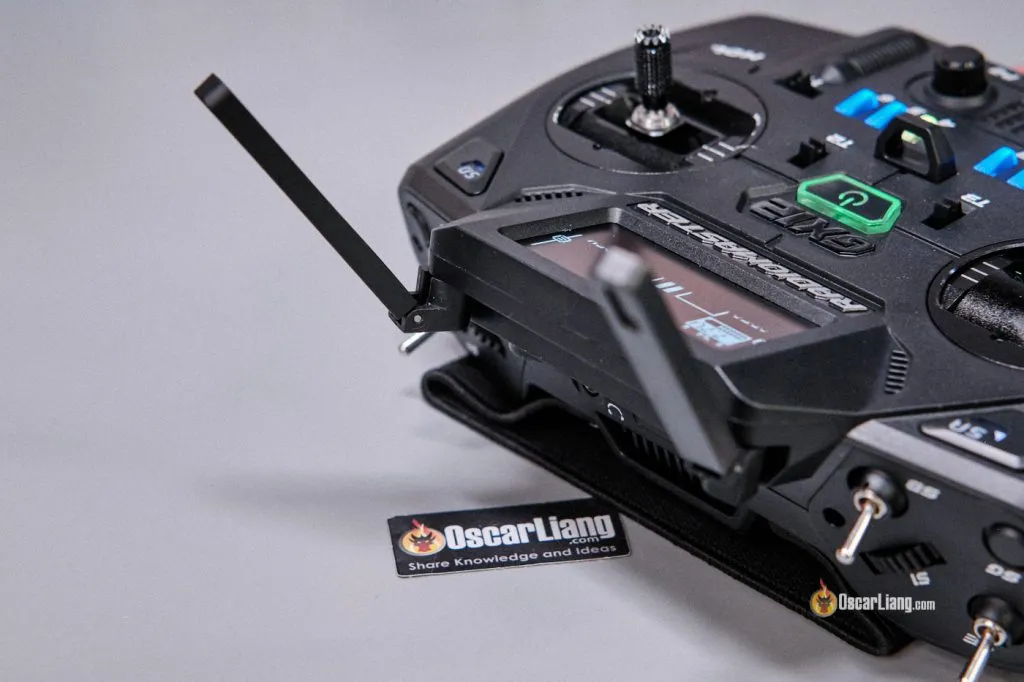
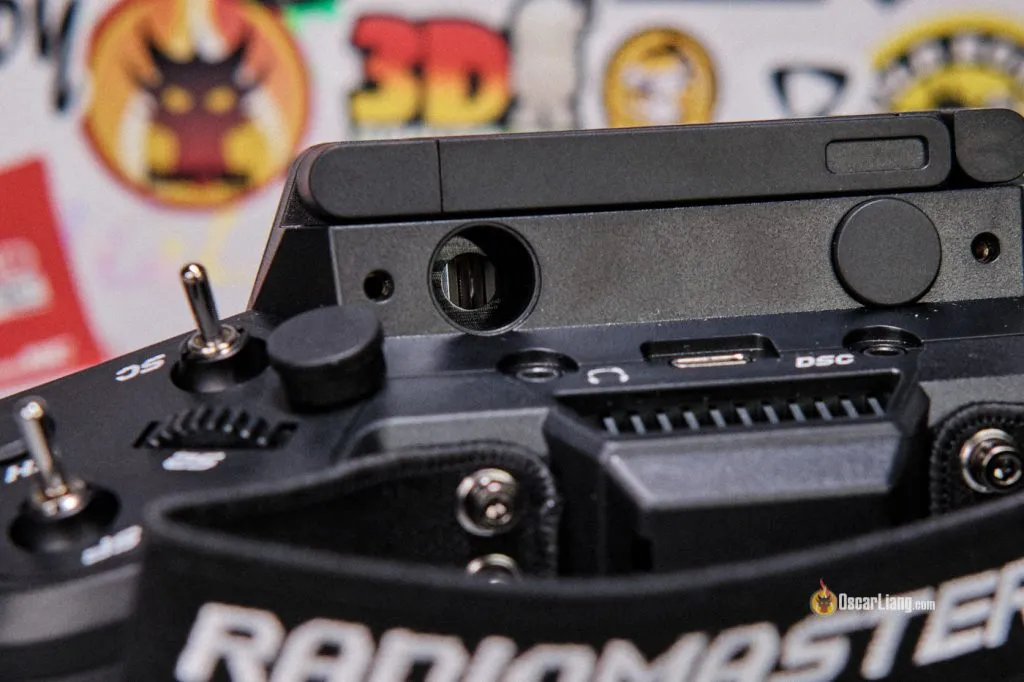
Power Consumption
Radiomaster GX12’s power consumption varies with ExpressLRS RF output power:
- 10mW: 0.49A
- 25mW: 0.50A
- 50mW: 0.55A
- 100mW: 0.64A
- 250mW: 0.90A
- 500mW: 1.16A
- 1W: 1.68A – 1.82A
Note a consumption increase between 100mW and 250mW due to the fan activation threshold at 250mW, adding roughly 0.1A. The fan’s noise is mild but noticeable.
Brightness adjustment on the display marginally affects power use, varying only slightly even at highest and lowest settings.
Battery and Charging
The GX12 uses 2S LiPo or Li-ion batteries, held in an adaptable holder for both button and flat-top 18650 cells, though 21700 cells won’t fit. Removing these can be difficult, so charging while in the radio via USB-C is easier.
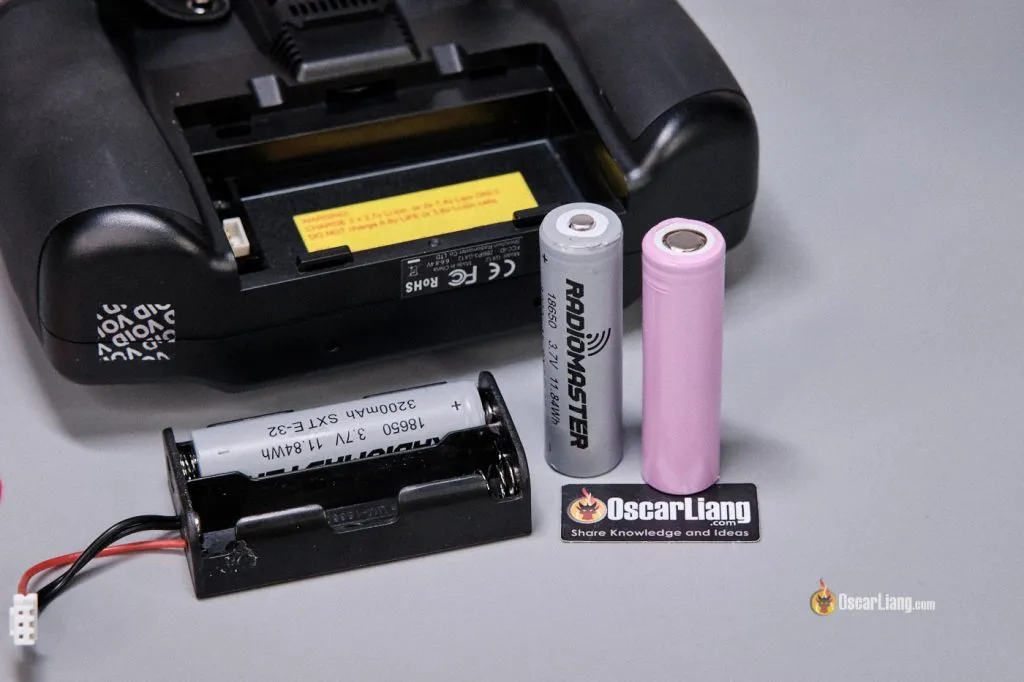
The compartment dimensions fit Radiomaster’s recommended battery, but larger packs like the Boxer’s won’t fit.
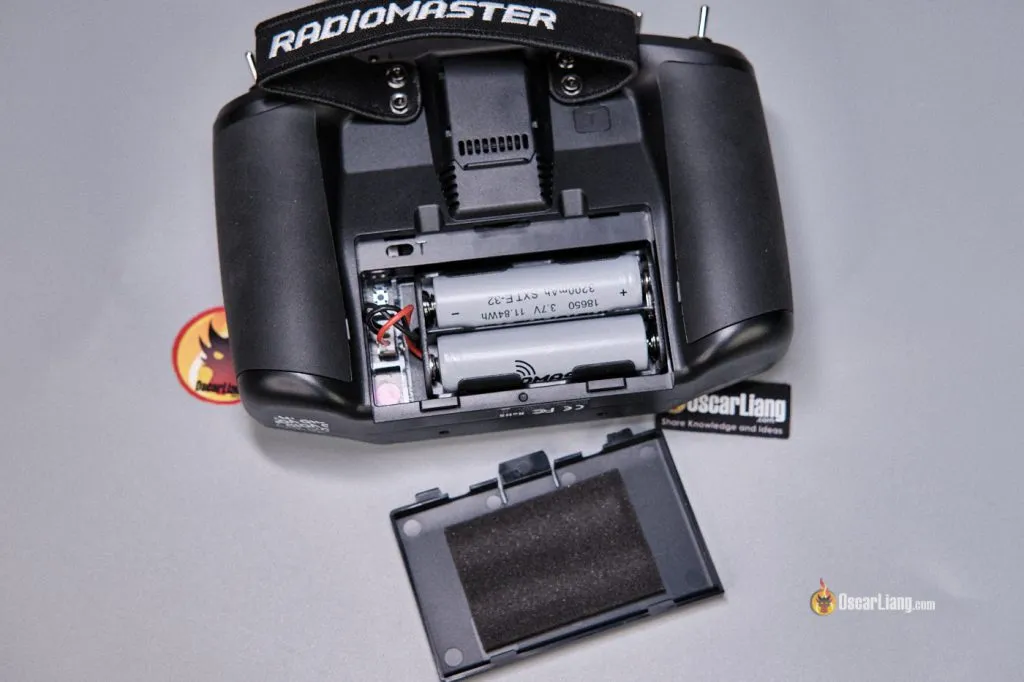
Battery Life Estimates
With two 18650 cells at 10mW power, battery life is about 6 hours. At 100mW, expect 4.5-hour longevity, and 1W drains in roughly 100 minutes.
Charging
The built-in charging circuit supports USB-C for LiPo and Li-ion, streamlining into one port. With up to 12W charging power, a full recharge takes 90 minutes to 2 hours for a 3200mAh battery.
- Charging Power: Up to 12W (5V 2.4A)
- Full Charge Time: ~90 minutes to 2 hours to recharge a 3200mAh battery.
Simulator Support
The GX12 works with popular FPV simulators, appearing as “TX16S” in lists, a minor technicality that doesn’t detract from use.
Tear Down
The GX12 disassembles easily with four rear hex screws, but a warranty sticker’s removal voids the manufacturer’s warranty.
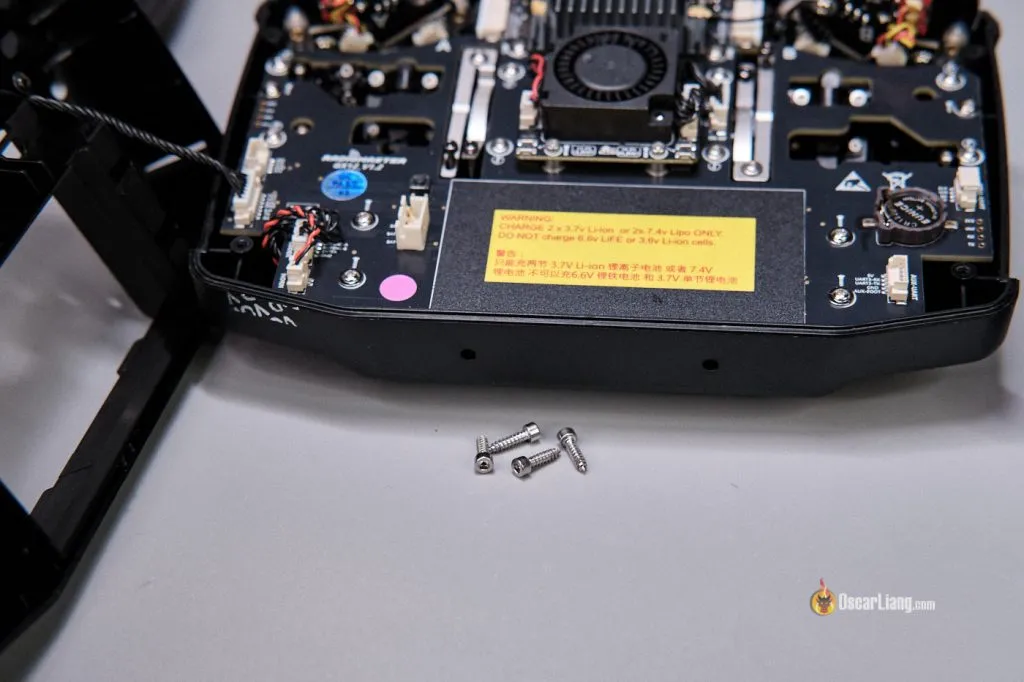
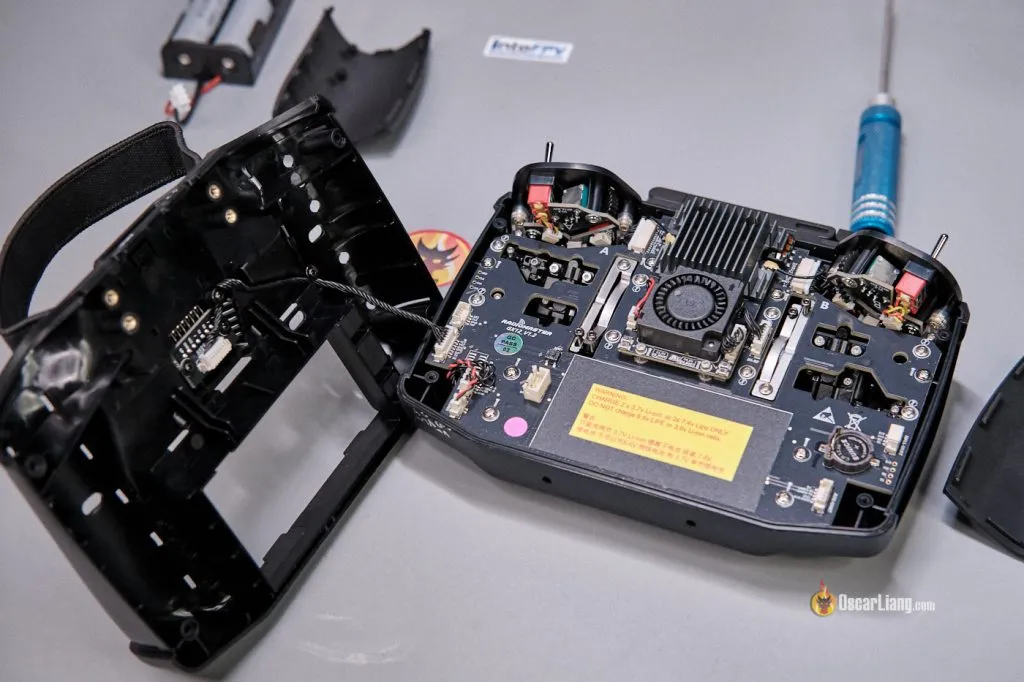
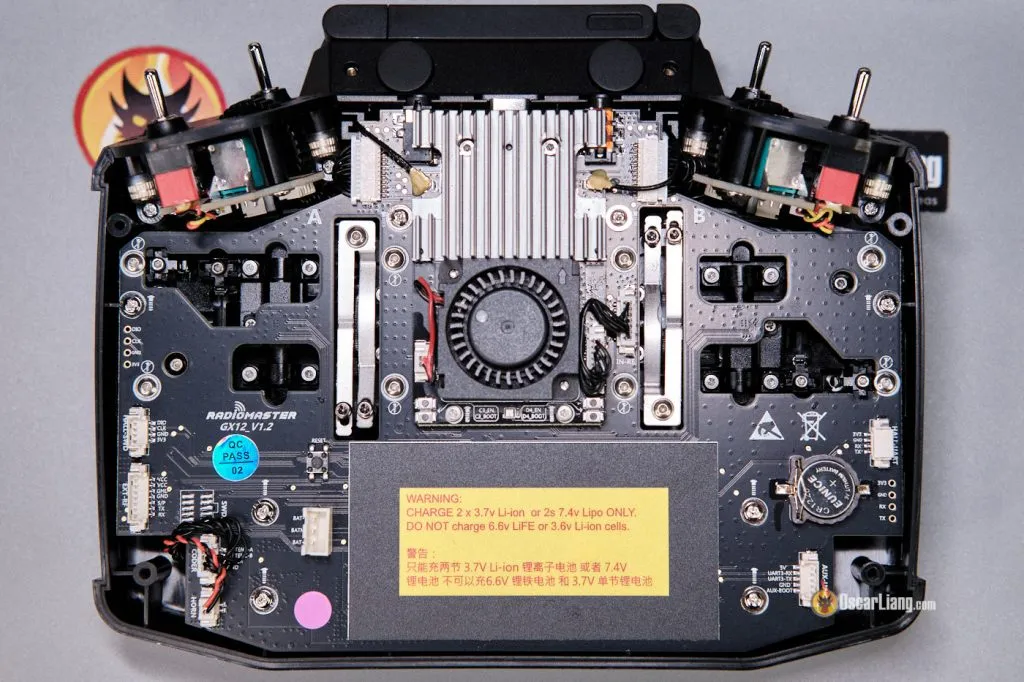
Drawbacks Summary
Despite its strengths, some design aspects might not suit everyone:
- Gimbal Size: Smaller gimbals reduce precision, but foldable sticks improve portability.
- Weight: At 670g, the GX12 is heavier than other models, slightly affecting comfort and causing top-heaviness.
- Dual-Band Antennas: While practical, they lack dedicated single-band antenna performance, requiring user modifications to optimize.
- Switches: Momentary switches reduce versatility; swapping some with toggles could broaden functionality.
- Display Choice: A large screen reduces compactness, detracting from a minimalistic approach.
- Wireless Trainer Support: The lack of this feature could be a limitation for head tracking users.
Final Thoughts: Is the GX12 Worth It?
The Radiomaster GX12 aims to be an all-encompassing solution, delivering a compact, feature-rich, and affordable transmitter for $169. It stands out for dual-band ExpressLRS and foldable gimbals.
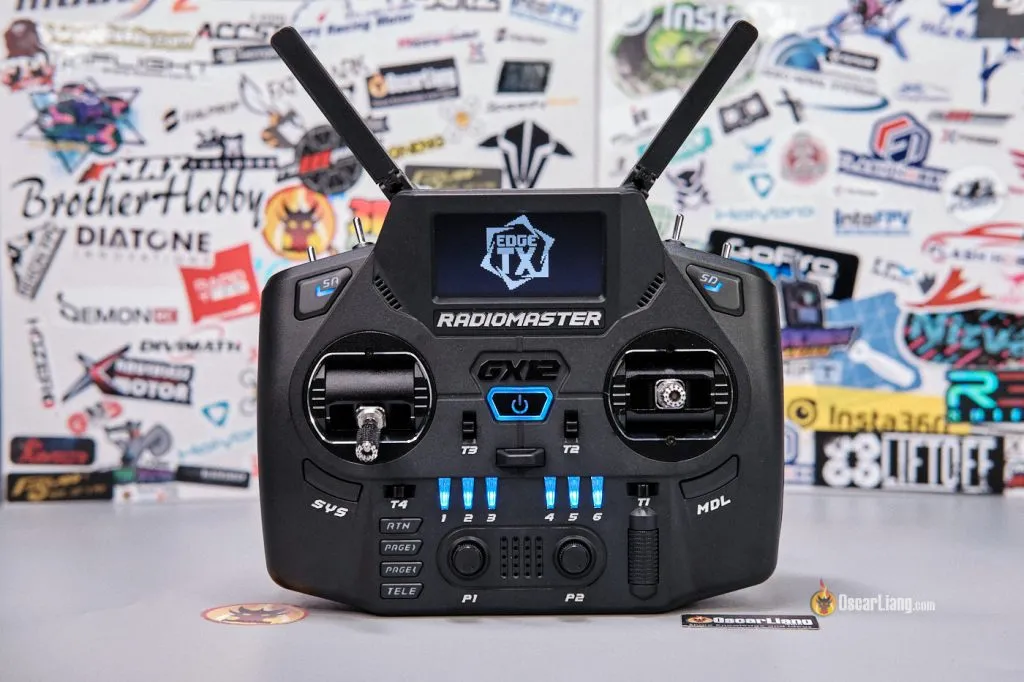
- Beginners might prefer simpler models like the Pocket or Zorro.
- Precision-centric pilots might choose full-sized gimbals in the Boxer or TX16S MKII.
- For a compact option with full-size gimbals, the T20S remains a top choice.
The GX12 shines in versatility, ideal for users needing a single portable radio for diverse uses beyond drones, extending into fixed wing. The $169 price, paired with Gemini-X technology, offers impressive value if its features align with your needs.
You can purchase the Radiomaster GX12 from these vendors:
If seeking a compact, customizable, advanced transmitter balancing cost and capability, consider the Radiomaster GX12 a strong contender.

All about Drones


